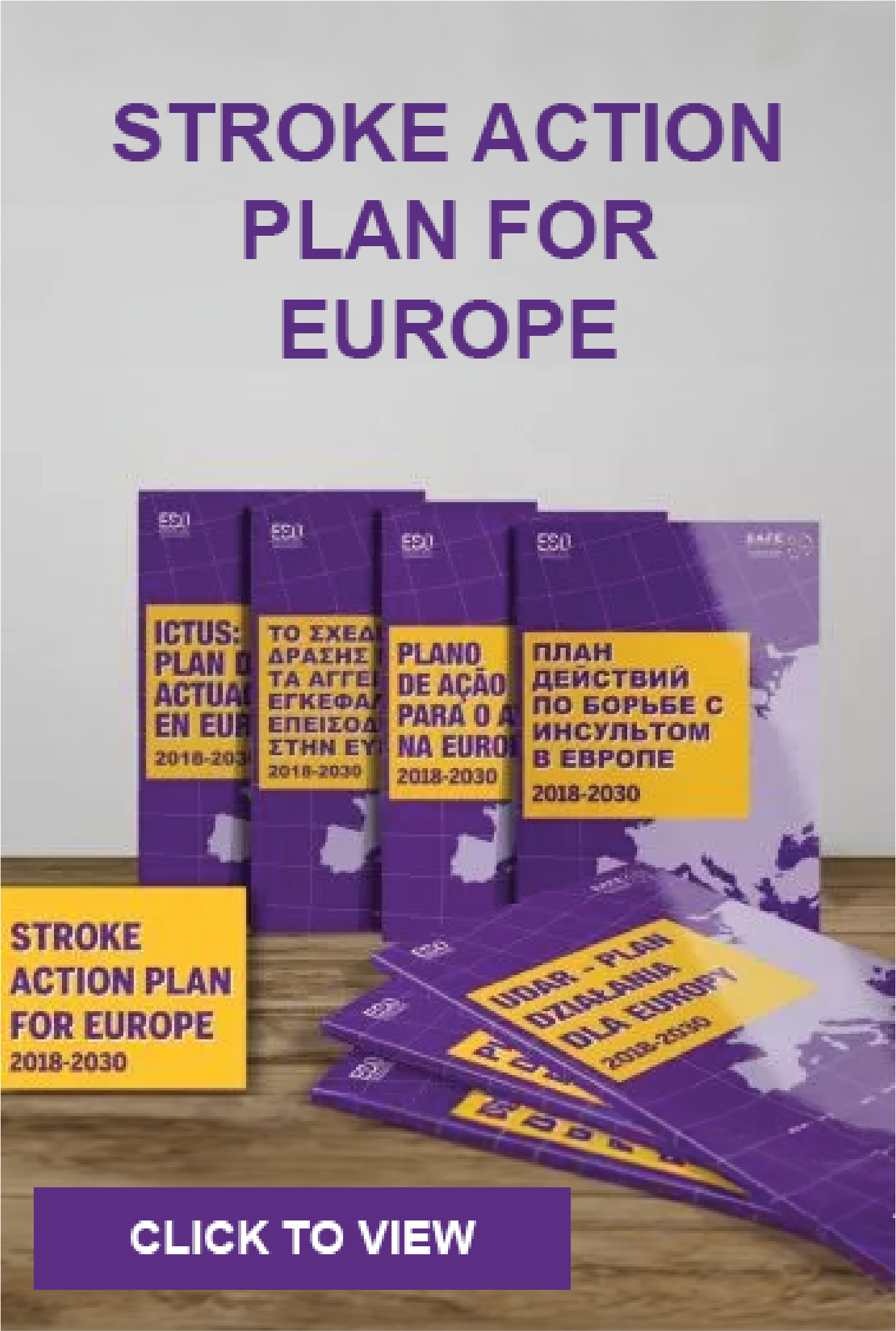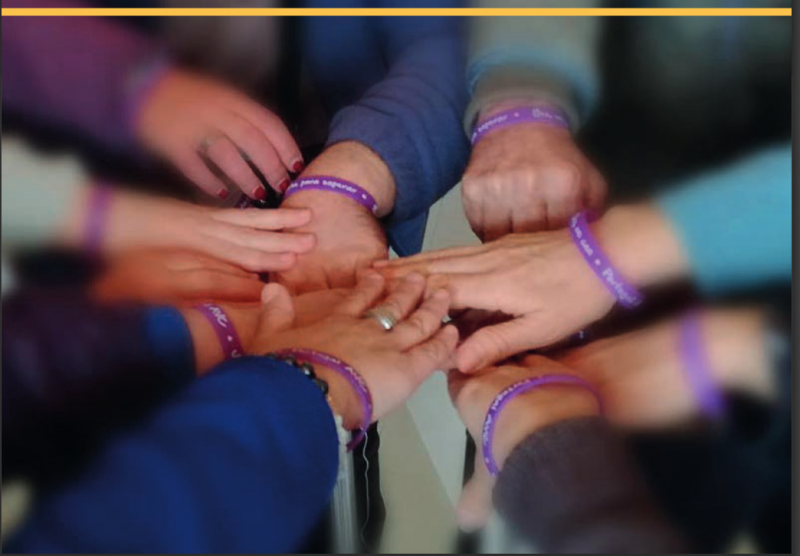
Apr 19, 2019
Portugal AVC, stroke support organisation and a member of SAFE, recently published a collection of 21 life stories of stroke survivors. We present you the text that Portugal AVC President, António Conceição, shared with us on this occasion.
…
Author: António Conceição
 We started with posting on Facebook 2 or 3 testimonies, that arrived to us, of people describing their post-stroke life. We quickly realized that these were the most read posts and that they had incredible reactions: We were contributing, with concrete examples, all very different among them, to the motivation of other stroke survivors!
We started with posting on Facebook 2 or 3 testimonies, that arrived to us, of people describing their post-stroke life. We quickly realized that these were the most read posts and that they had incredible reactions: We were contributing, with concrete examples, all very different among them, to the motivation of other stroke survivors!
That way, throughout the next year, we challenged some survivors and caregivers to give their testimony. With completely different life stories, some of them truly difficult, but with something in common: to show how it is possible, even with adaptations, to rebuild a life and reach happiness again!
We have gathered 21 life stories, available on our website, truly extraordinary, with different ages, circumstances and time passed after the stroke. All of this with a worry in the background: to take strength where it seems to lack!
We thought about putting into paper these amazing life stories, to make them more accessible, and in a lasting way. We found a writer of children’s books, a psychiatrist that doesn’t practice, an extraordinary and very sensible person, and we challenged her to compile all of these testimonies, with total respect for the story and style of each person.
Out of this came out a book that has had fantastic reactions, a lot more than what we were expecting. As the writer wrote in the preface: “When nothing seems to be in favor, there is still an unknown inner strength left, a never seen before resilience, an unbelievable ability to overcome, a selfless and unconditional love that no one imagined possible… (…) With more or less difficulties, you are able to discover a new life path, with the goal of accepting what seemed unacceptable. (…) And, if in a sea of physical, emotional, social, familiar, logistic and financial problems, there are those who are able to turn their lives around and find the inner peace and sense of life that most human beings look for, that means it is possible to survive, it is possible to win, it is possible to restart!”.
The book was published on the National Stroke Survivor Day (31st March) and had a formal launch on the last Portugal AVC Meeting (13th April).
It’s one step further in the path of Portugal AVC, who has as one of the main goals to support the stroke survivors in the path of rehabilitation and integration, as complete as possible!
About Portugal AVC
Founded on September 23rd, 2016, the Portugal AVC represents the 1st national associative entity led by stroke survivors of stroke. It includes stroke survivors’ family members, as well as health professionals, caregivers and friends who embrace this cause.
The Portugal AVC is made by and with stroke survivors, who cover three out of five positions in the Executive Board, including the President.
Photo credit: Portugal AVC
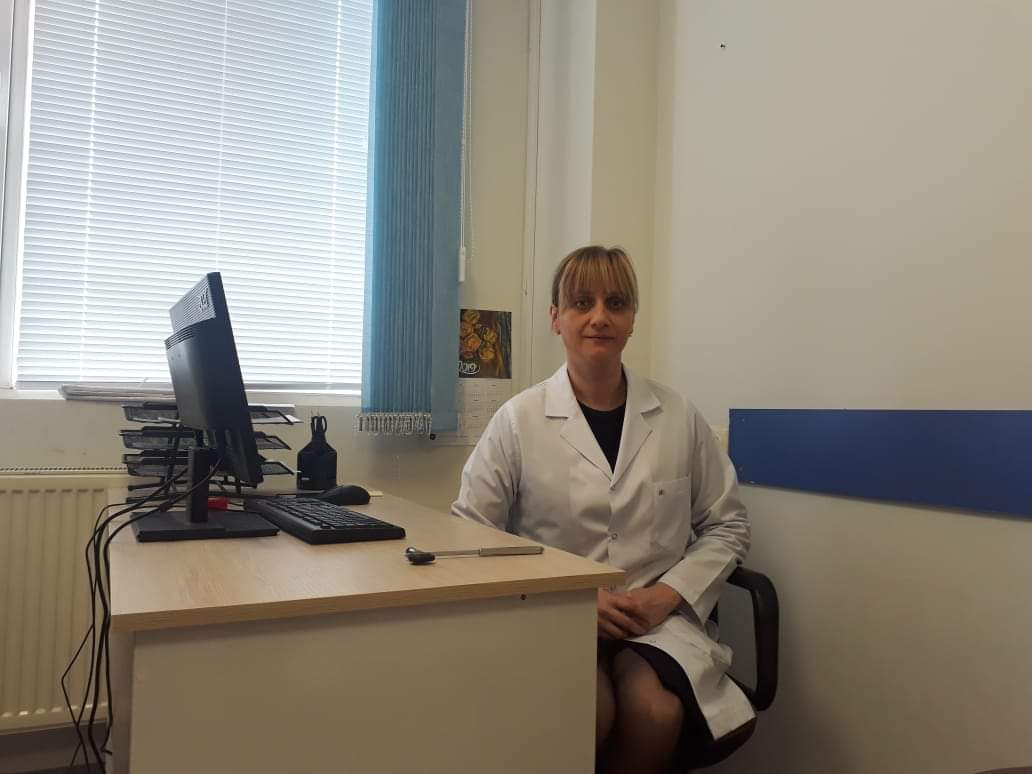
Apr 19, 2019
“There is no stroke rehabilitation center in Kutaisi, Georgia, and after their hospital treatment, patients are discharged to go home. Unfortunately, patients’ carers do not have enough information on how to take care of them once their loved ones are back home. Due to swallowing problems, many of stroke survivors return to the hospital very soon after their discharge, this time not because of stroke, but because of aspiration pneumonia- a type of lung infection that is due to a relatively large amount of material from the stomach or mouth entering the lungs” says Tamar Janelidze, MD, neurologist, co-founder and board member of Georgian stroke support organization, Medical Foundation Mkurnali.
SAFE: What is one issue related to the life after stroke in your country that you think needs special attention?
TJ: In Georgia, there is an observed growth trend in cerebrovascular diseases. For last years, at the national health sector level, special attention is paid to acute strokes. In general, stroke is one of the main causes of disablement of the population of Georgia. In particular, most of patients that survived stroke are disabled, and 30-40% of them needed permanent care. Because of a deficiency in rehabilitation services in Georgia, no correction of neurological impairment can be made completely for stroke patients that reduces the quality of life. In response to the urgency of this disease, it is very important to study the methods for fighting this disease and for the management of its complications, as well as for its proper diagnosis.
In Georgia, at our hospital, at the premises of the neurology department, there have been established the stroke management units, the so-called stroke units, which allow not only for effective treatment of stroke patients, but also for assessing the complications and possible risks associated with stroke. 65% of patient had dysphagia, which evolves as a result of infringement of brain blood circulation, and appears as inhibition of swallowing reflex, or as its complete elimination.
SAFE: What would be the solution, i.e. what is your organisation’s position regarding this issue?
TJ: There is the risk of an aspiration of foods in the airway that consequently may lead to aspiration pneumonia. Our organization contributes to the introduction of dysphagia screening in the neurology department, which include the studies were actively started for the detection of dysphagia. First, swallowing reflex is checked and lingual condition is assessed in all patients, as well as there is differentiated whether dysphagia is a neurological complication or not. Then the studies are carried out through video-photofluorography roentgenoscopy. Patient swallows the contrast substances of different consistencies, and radiologist assesses radioscopically the swallowing process. Also, in some cases, of high importance is to assess the pharynx condition, for which we apply to an endoscopy.
After the mentioned examination, an attending physician and radiologist make decision on how the dietary regime of patient should be carried out. Of all 120 examined patients, dysphagia was detected in 85, and an appropriate examination regime and treatment were chosen for them, and in some of them the need of gastrostomy was identified. Analysis of latest data has shown that the problem of proper diagnosis of dysphagia allows for reducing the complications, even such as aspiration pneumonia that in turn is the most dangerous complication in terms of mortality.
Thus, proper diagnosis is a guarantee of preventing possible disablement and anticipated mortality.
SAFE: Please tell us more about your organisation.
TJ: Our organization participates in s patient’s educational program not only for stroke patients. We also have relations with government of Kutaisi and also Kutaisi University and try together to make our patients’ lives better.

Apr 19, 2019
Author: Nora Mork
People with a chronic pain are constantly facing obstacles and difficulties that they otherwise wouldn’t. However, this doesn’t have to mean that it’s impossible to have a full and satisfying life even with the chronic pain.
You just have to learn to live with it properly and avoid making these common mistakes:
Allowing Fear To Rule Your Life
Fear is understandable in this situation but what is not is allowing it to rule your life. You are still you and there are always ways to fix this situation. There are medications available and many other things that could help you overcome your pain and have a regular life. Certainly, nothing will go back to being completely normal but maybe you should embrace your new normal instead.
Misusing the Pain Meds
Pain medication should never be used to completely block your pain. This is impossible because those pain medications become ineffective over time. They can be really helpful but it all depends on how you use them and what you expect will happen because of them.
Pain medications can only remove about 50 to 60 percent of pain. You’ll have to use other things as well to support the meds. You have to learn to live with a certain amount of pain.
You should also avoid using the pain meds to do more and get through certain things. You can’t move too fast in your recovery process and end up having more pain than before. Stick to the schedule and what your doctor told you.
Overwhelming yourself when you are feeling okay
At times you’ll feel a lot better – almost like normal – and you’ll realize that these are the times that you can do things like you used to. Soon, you’ll increase the amount of work you do during “good times”.
But this will only increase your amount of pain and result in you not being able to fix it later. Never overwhelm yourself when you are feeling good. Take frequent breaks and rest often – sit or lay down, change your position as necessary and don’t do the extremely difficult things.
Find the right kind of help
“Pain management counselors can really help you learn pain management techniques and how to move on with your life properly. Don’t think that the relief can only come from pills. You have to learn other, more effective and natural ways of managing your pain. And you can really learn a lot from these professionals,” says Hannah Thomas, a psychology blogger at Academized and Australian help.
But, you also have to learn to rely on yourself – physicians are there for you but they are there to teach you how to handle yourself and your pain, not to be available to you any time of day or night. They also can’t always understand what you are going through.
This is why you have to understand to rely on yourself but also find a support group that can help you with their experiences and so on.
Not learning about your patterns
 As you go through the process of being in a severe pain through feeling just small amounts of pain, you will learn to understand and recognize your patterns. For instance, when it happens and what happens. Ask yourself whether some fears or certain emotions make things better or worse for you. If some people have an effect on your pain – be it a good one or a bad one.
As you go through the process of being in a severe pain through feeling just small amounts of pain, you will learn to understand and recognize your patterns. For instance, when it happens and what happens. Ask yourself whether some fears or certain emotions make things better or worse for you. If some people have an effect on your pain – be it a good one or a bad one.
Then, you can learn to avoid of milden these effects. This is a great way to learn to live – in part – with the pain.
Thinking that you can’t go on
“Everyone sometimes feels like they can’t keep living in pain and they feel desperate but they are wrong. People can survive anything and still have a full and happy life with pain.
So, learn to live with it and overcome it in difficult situations,” says Milo Banks, a health writer at Big Assignments and State of writing.
Failing to refill your prescription
For one, you need to remember to always refill your prescription – meds aren’t the only pain management that you should use but they should still be a part of it. Failing to do so will only result in your recovery slowing down.
You should also remember to refill it in time – for example, never let your meds run out during the weekend or holidays, get a prescription before that. The doctors have their own lives which they shouldn’t have to stop in order to get to you because of your mistakes.
Having chronic pain is scary but it’s also possible to have a good life with this illness. Hopefully, you’ll avoid these mistakes and have a good life.
About the author: Nora Mork is a health and psychology writer and editor at UK Writings. She helps people by sharing her experience in the articles at Boom Essays and Essay Roo blogs.
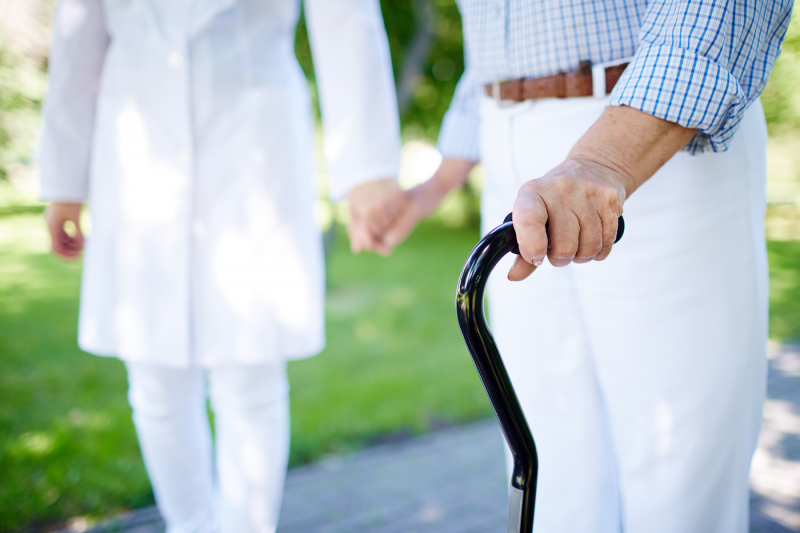
Apr 17, 2019
This article was first published on ESO website | Author: Giuseppe Reale, MD – ESO YSPR Committee
Same stroke, same treatment and lower limb weakness, but forget about upper motor neurons!
Sometimes it seems that stroke treatment is all about time, tissue and recanalization, whatever it takes. However, it is important to remember that danger might be just around the corner, even after a successful recanalization.
A 66-year old man was carried to our Emergency Department 4 hours after the acute onset of right hemiplegia and aphasia. CT-Angiography (CTA) showed a M1 left middle cerebral artery (MCA) occlusion and the patient underwent to systemic thrombolysis followed by mechanical thrombectomy in general anesthesia with right femoral access. When the patient was admitted to the Stroke Unit, he presented only right lower limb weakness, being able to flex the thigh at hip, but not to extend the leg at knee. The right patellar tendon reflex was absent, while the left was elicitable. The segmental weakness pattern and the reflex asymmetry suggested a femoral neuropathy. CTA of lower extremities excluded the presence of iliacus hematoma or femoral artery aneurysm. The patient had a spontaneous recovery of the neurological deficits within one week. The electromyography performed three weeks later did not show any finding of denervation at the quadriceps muscle, suggesting a previous femoral neuropraxic block.
An 82-year old woman with the same symptoms and radiological findings of the previous patient underwent thrombolysis and thrombectomy with right femoral access in general anesthesia.
When transferred to the Stroke Unit, she presented just a mild drift of the right lower limb, but the day after she developed a complete plegia of the right lower limb associated with “mild pain and an unpleasant cold sensation”. The right lower limb was cold and distal pulses were absent. CTA of the lower extremities demonstrated a pseudoaneurysm of the common femoral artery, associated with distal arterial occlusion. The patient underwent emergency femoral endarterectomy without any complication.
You can read the full article here.
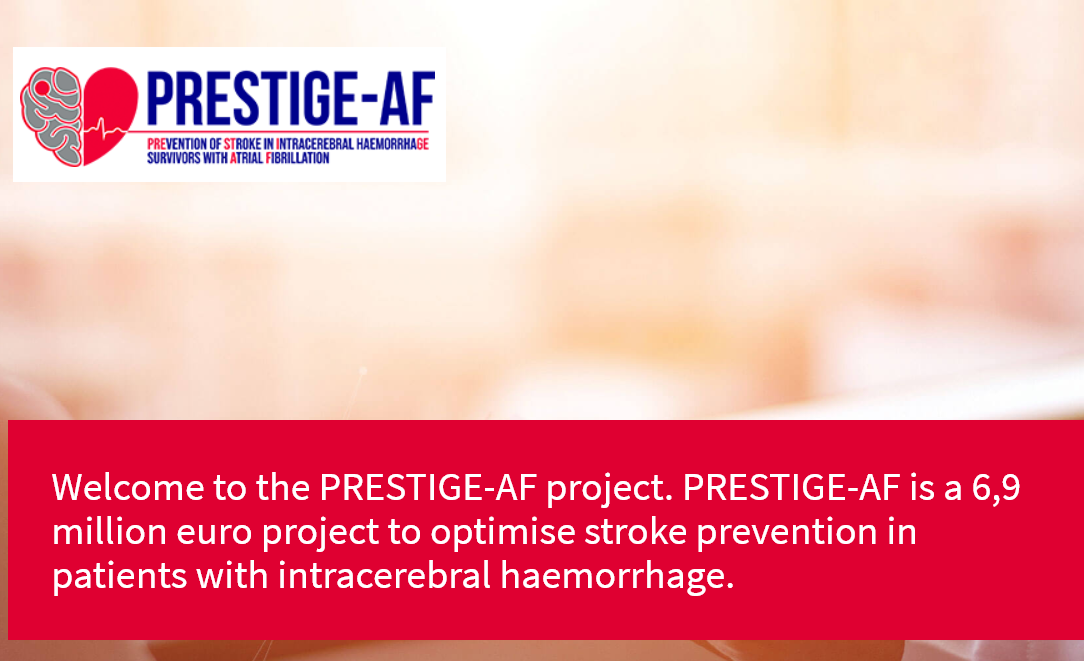
Apr 16, 2019
This article first appeared on the PREvention of Stroke in Intracerebral haemorrhaGE survivors with Atrial Fibrillation (PRESTIGE-AF) website
The PRESTIGE-AF team are going to Milan in May to participate in one of Europe’s leading forums for stroke research, the European Stroke Organisation Conference (ESOC).
The European Stroke Organisation Conference is a premier European forum for stroke research and rapidly becoming the global platform for the release of major trial data. Last year the conference welcomed over 4,500 participants from around the world with 1800 abstracts submitted, and over 1300 e-posters on display. With one participant suggesting “it is the stroke conference in Europe I think at the moment (participant from ESOC 2019 promotional video), the 2019 conference will provide a unique opportunity for the PRESTIGE-AF team to network with fellow clinicians and scientists.
The PRESTIGE-AF team will present, discuss and trade expertise in the most rapidly evolving area of stroke management and care. We have quite a few from the PRESTIGE-AF team presenting at the conference including the project’s coordinators from Imperial College London, Roland Veltkamp, Stephanie Debette from Universite de Bordeaux, and Joan Montaner from Vall d’Hebron Research Institute (VHIR). Roland will convene the session on Intracerebral Haemorrhage and do a short presentation looking at the causes of recurrent ischemic stroke after embolic stroke of an undetermined source. The team will take full advantage of the conference with holding their own Investigator Meeting and Steering Committee breakfast.
ESO president Bart van der Worp, notes that “ESOC 2019 will be even greater…with major trial results to be presented” (ESOC Youtube Video), so we are looking forward to the team’s review of the conference including presentations of major clinical trials.
Go to the website for more information about the 2019 European Stroke Organisation Conference.
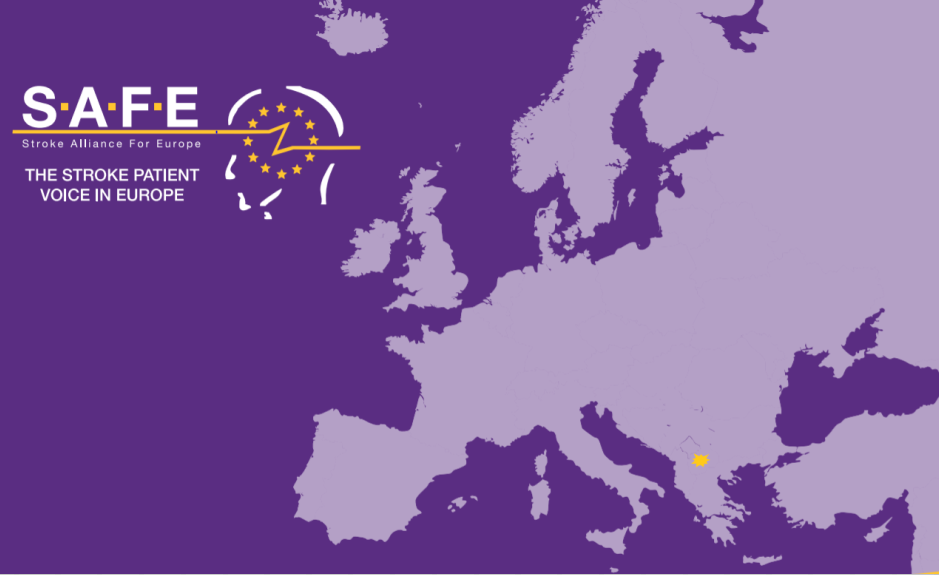
Apr 12, 2019
As announced earlier, SAFE will open conversation with our member organisations’ leaders, in the attempt of shedding light on life after stroke issues across Europe.
This week we are talking with Dr Maja Bozinovska Smiceska, President of Association for a fight against stroke “Stroke” in North Macedonia.
SAFE: What is one issue related to the life after stroke in your country that you think needs special attention?
 MBS: Every stroke is different, and so is the recovery that follows. Patients suffer not just physical problems like weakness and impaired gait, but also difficulties with language, memory, cognition and emotional problems. Patients everyday life changes and become full of obstacles and frustration.
MBS: Every stroke is different, and so is the recovery that follows. Patients suffer not just physical problems like weakness and impaired gait, but also difficulties with language, memory, cognition and emotional problems. Patients everyday life changes and become full of obstacles and frustration.
One aspect regarding rehabilitation in their recovery is intensive work with multidisciplinary team. So, the first problem in our country is deficiency of such team in most of our cities or inequality in specialized stroke recovery. All stroke survivors have approach to physical therapy, part of them of them have language therapy at disposal, but just a small percentage have luck to be rehabilitated by a multidisciplinary team.
Second very important problem is that there is no national strategy, a specific path, that will simplify the struggle of patient and family. Considering not just rehabilitation but also their adaptation to situation and inclusion in society, helping them to be productive as possible or providing to others specific help according to their needs like financial help or accommodation.
SAFE: What would be the solution, i.e. what is your organisation’s position regarding this issue?
MBS: As the only organisation that deals with stroke patients in our country, we are continuously increasing public awareness and educating public using different media, where and how to find help and to whom to address their specific problems. Also our network is offering annually reviewed data. We organise lectures for specific groups considering certain post stroke problems. Our organisation in 2017 formed a special team consisting of Stroke neurologists, nurses stroke survivors and caregivers that created a document in which we included recommendations for life after stroke. Members of our team already had two meeting in Ministry of health of Northern Macedonia, and this document was given to the counselor of the minister. What we consider important is forming a team in Ministry of health that deals with the issues of stroke, generally they should create and implement national strategy.
Our next goal is to organise peer to peer meetings and that way to improve self-management in stroke survivors and caregivers.
SAFE: Please tell us more about your organisation.
MBS: Our organisation is formed 2014. Our idea was to improve stroke care in our country that was very poor and unequal in different regions. Main goals of our organisation are raising the consciousness of the public and education; join care for improving the health condition of the patients with a stroke; informing about the new scientific and practical achievements in the treatment of the patients with a stroke; providing professional help in the field of action; encouraging and strengthening the cooperation with domestic and foreign organisations and institutions which have same or similar goals. We started with activities for stroke prevention and post stroke consultations for patients and caregivers that included not just spreading information trough media but also field work of teams consisting different specialists, doctors, nurses, clinical psychologists and physiotherapists in different cities. These activities are still going on, and we have upgraded our work. Our organisation is now member of SAFE and WSO.

Apr 12, 2019
Author: Aidan Judd
In 2016 and 2017, broadcaster Mark Goodier suffered two strokes. He found when he got home from hospital, there were not that many resources to use as part of your recovery. And once you are away from constant medical supervision, it can be a lonely time as family and friends get back to their daily lives.
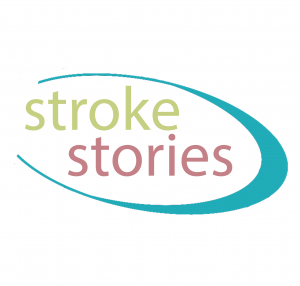 Mark started the Stroke Stories podcast to seek out and hear from stroke survivors.
Mark started the Stroke Stories podcast to seek out and hear from stroke survivors.
In every episode, we hear a different stroke survivor – we hear about their condition, what inspires them, and the lessons they learned on the road to recovery.
Every stroke is different, and we reflect that in the people that we talk to for the podcast. Since November 2018, when the first episode was released, we’ve spoken to people from all different ages, backgrounds, and nationalities:
Nick and Jo Cann
Nick had a stroke when he was 50. After the stroke he found that there was a lack of support in his area for him and other stroke survivors. Despite suffering from aphasia, Nick speaks at events across the UK to raise awareness of stroke, and has also set up a support cafe meet up.
Connor and Sarah Lynnes
As a result of an injury he had whilst playing rugby, Connor had a massive stroke at just 14 years old. Connor has now set up his own foundation, to help other young survivors of stroke and brain injuries.
Clodagh Dunlop
A front-line police officer, Clodagh Dunlop was only 35 when she suffered her stroke. As a result, she experienced locked-in syndrome, which meant she was unable to move or speak. However, after 7 months of intense physiotherapy, she walked out of hospital, and is back working full time in the police force.
Antonio Iannella
Antonio suffered a stroke at the age of 38 whilst in holiday with his family in Vietnam. Since then, he has recovered well, and pursued a lifelong dream of opening and running a music recording studio in his home.
We want to spread the message as far as possible. If you are a stroke survivor and would like to feature in a future episode, then please contact SAFE, or DM us via our Twitter account – twitter.com/strokestories
Updated with new episode released every week, Stroke Stories seeks to inspire and reassure with real life stories from stroke survivors and their families.
There are currently over 20 episodes available through iTunes (https://itunes.apple.com/gb/podcast/stroke-stories/id1442493312?mt=2) and on ACast (https://play.acast.com/s/strokestories)
For the latest updates, follow Stroke Stories on Twitter – www.twitter.com/strokestories and Instagram www.instagram.com/strokestories
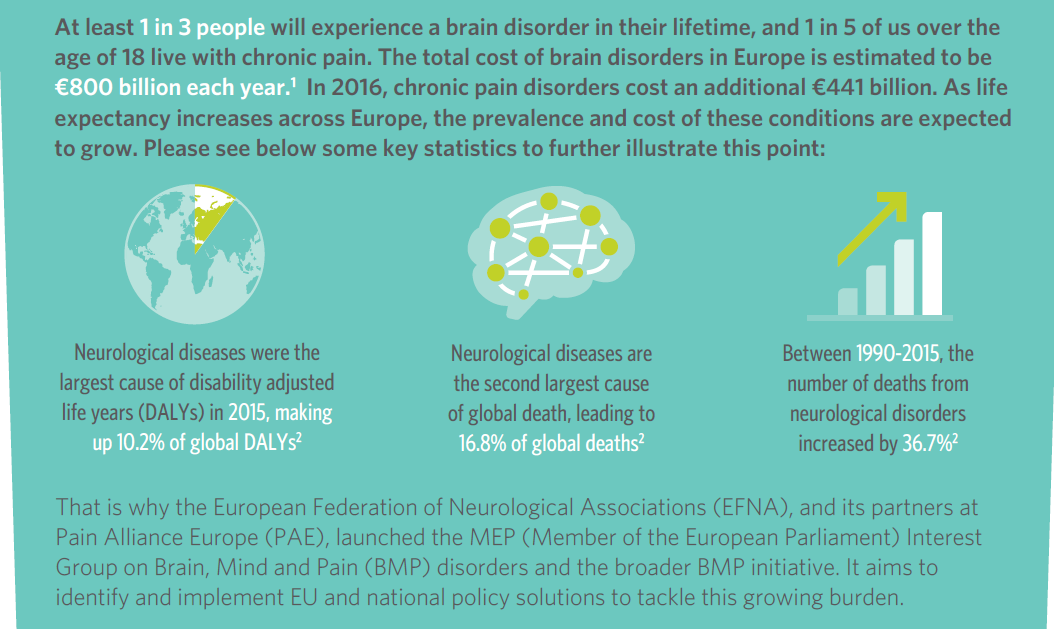
Apr 12, 2019
The Brain, Mind and Pain (BMP) initiative has today launched its Book of Evidence for the 2019-2024 EU mandate.
This Book of Evidence (BoE) sets a strategic vision on policy action to deliver better care for people with neurological and chronic pain disorders in the EU.
It will be used as the core policy document of the MEP Interest Group on Brain, Mind & Pain – which will continue after the upcoming EU elections for the next 5 year mandate.
The Interest Group is coordinated by European Federation of Neurological Associations (EFNA) and Pain Alliance Europe (PAE).
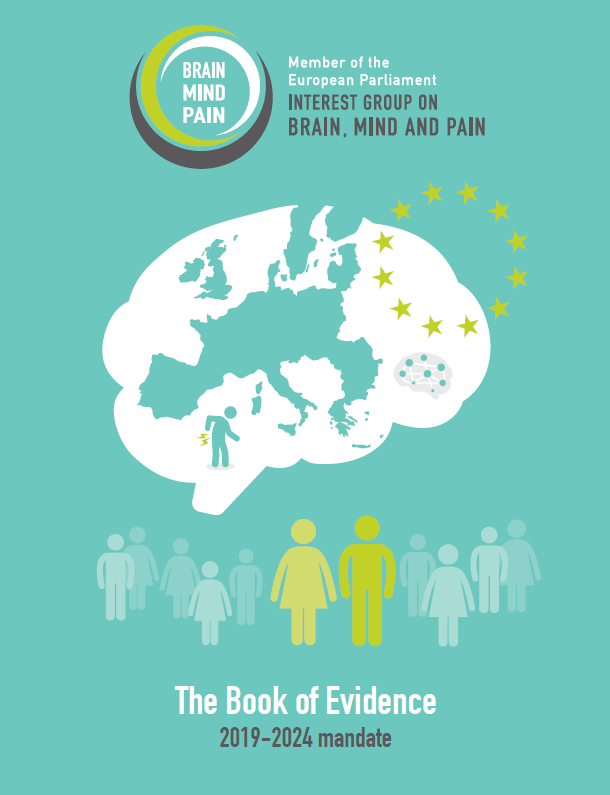 The BoE outlines clear focus areas and proposes recommendations for policy actions, which, if implemented, would significantly improve quality of life for people with neurological and chronic pain disorders, as well as their families and carers.
The BoE outlines clear focus areas and proposes recommendations for policy actions, which, if implemented, would significantly improve quality of life for people with neurological and chronic pain disorders, as well as their families and carers.
The development of the document was led by EFNA and PAE and involved a wide range of key EU and national stakeholders from the patient, policy, industry and scientific communities.
This collaborative development process is reflected in wide ranging endorsements and support from organisations such as the European Commission, European Brain Council, European Patients’ Forum, European Academy of Neurology, European Pain Federation and European Alliance for Patient Access.
Key areas for action
The BoE outlines the thematic areas of focus for the MEP Interest Group on Brain, Mind and Pain for the 2019-2024 mandate. These are:
» Eradicate stigma, isolation and discrimination: A lack of public awareness of BMP disorders feeds their stigma and the associated isolation and discrimination suffered by BMP patients, carers, and their families.
» Ensure equitable access to treatment, services, and support: Access to treatment, services, and support is a topic of concern for patients in Europe due to high failure rates, delays in market access, relatively expensive treatments, and inequality in access across, but also within, EU Member States
» Promote patient empowerment for increased involvement and engagement: Patient empowerment is a means for more effective BMP patient engagement and meaningful involvement in the research, medical and policy conversations which affect them
These areas have been chosen in order to support the MEP Interest Group in leveraging current policy opportunities on the agenda whilst ensuring continuity with the past activities and successes of the BMP initiative.
Driving policy change
The 2019-2024 mandate brings with it an active policy environment at EU level, with numerous opportunities for advocacy on behalf of people with brain, mind and pain disorders.
Ensuring that the Interest Group is capable of impacting policy discussions throughout the 2019-2024 mandate will be key in making progress in the three key thematic areas identified.
Additionally, with the global priority turning more and more towards NCDs, we need to ensure that brain, mind and pain disorders are part of global health policy agenda.
To this end, each chapter of the BoE contains a section on the policy opportunities and subsequent actions that can be leveraged to further progress in each thematic area and at EU and global level.
Looking ahead
It is now the responsibility of the Interest Group and the wider BMP initiative to leverage the policy opportunities and pursue the policy actions identified in this text throughout the 2019-2024 mandate.
EFNA President, Joke Jaarsma says: ‘Progress is contingent on coordinated policy advocacy at EU and global level, taken forward by the BMP initiative as a whole and its partners.
‘Using the BoE as a springboard for action, let’s drive policy change and make a real difference to the daily lives of people living with BMP disorders across Europe!’ she continued.
For any further information on the BoE or the activities of the BMP initiative – including its MEP Interest Group – please do not hesitate to contact EFNA at: advocacy@efna.net
For more contact:
Tadeusz Hawrot
EFNA Senior Advocacy Coordinator
advocacy@efna.eu
Elizabeth Cunningham
EFNA Communications Manager
communications@efna.eu
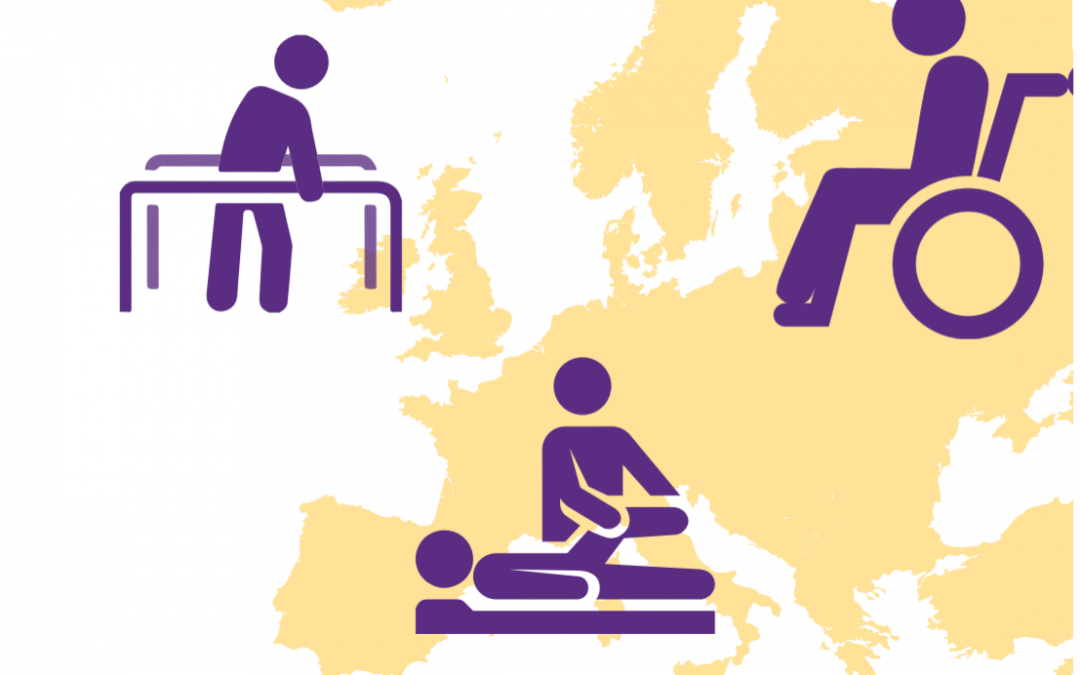
Apr 9, 2019
This year’s main theme for SAFE’s campaigning work is Life After Stroke, the issues around it and how the stroke survivors and their families are coping with it. The campaign will cover this year’s European Stroke Awareness Day in May and will culminate on October 29, for the World Stroke Day, when SAFE will present the Economic Impact of Stroke in Europe Report.
Stroke is responsible for 9% of all deaths each year in the EU and it is also the largest cause of adult disability. Total costs for stroke were estimated at €64 billion across Europe in 2010 and yet it is hugely under-funded in comparison to other chronic conditions. The most important risk factors for stroke are age, high blood pressure, obesity and diabetes, all of which are rising in a larger and increasingly elderly population living unhealthy lifestyles. Recent modest improvements in acute care mean that more people are surviving stroke, but with impairment, with the consequence that we have a major health economic and social burden catastrophe waiting to happen. This will severely impact all EU countries but especially those where inequalities in stroke healthcare are already known.
In 2017, SAFE has commissioned a research project on the economic impact of stroke in Europe. A health economics team from the University of Oxford is now finalising the report, which will be launched by SAFE in October 2019, for the World Stroke Day.
In anticipation of the final results, SAFE would like to remind the public that the absolute number of people living with disability from stroke has been increasing over the past three decades, and this is projected to increase. LMICs (low and middle income countries) have been disproportionately affected by stroke, and disability-adjusted life years (DALYs) from stroke have been generally increasing in LMICs.(1)
For this reason, SAFE is opening a conversation stream with leaders of our member organisations from 30 European countries. Each week, our readers will have an opportunity to read about one burning life after stroke issue in different countries. The series of interviews will shed light on specific country by country needs of stroke survivors and their families.
The slogan of this year’s campaign is: A life saved must also be lived, by Grethe Lunde from Norway, a Stroke Survivor and SAFE Board member.
(1) Feigin VL, Norrving B, Mensah GA. Global Burden of Stroke. Circ Res. (2017) 120:439–48. 10.1161/CIRCRESAHA.116.308413
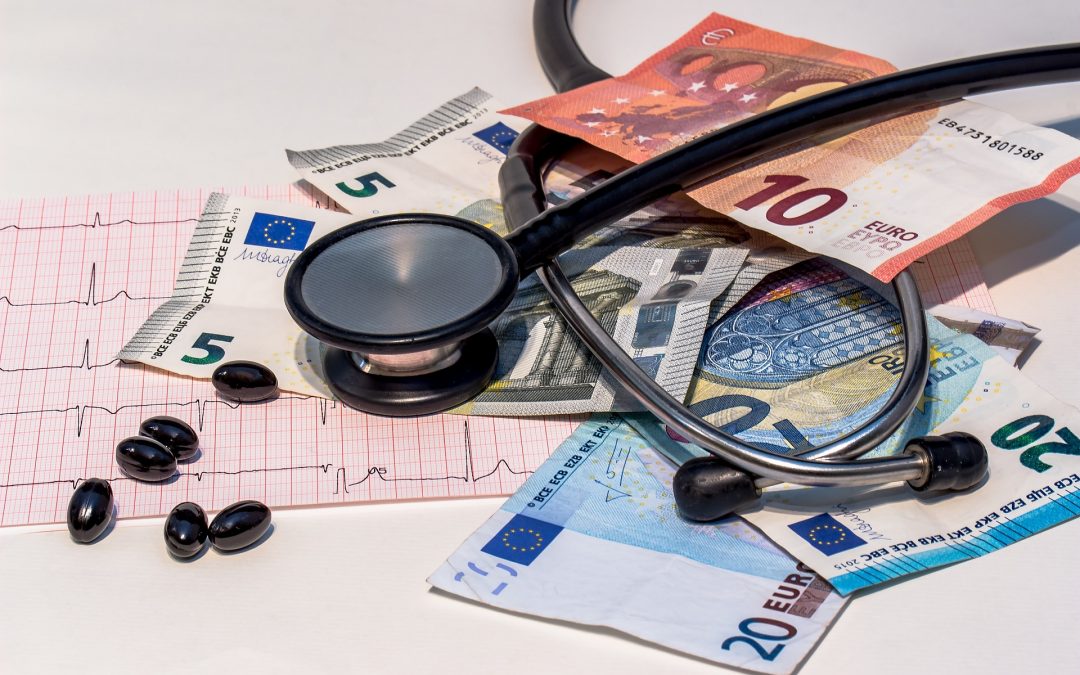
Apr 8, 2019
First published on ScienceDaily.com
The full financial cost of a heart attack or stroke is twice as much as the medical costs when lost work time for patients and caregivers is included.
That’s the finding of research published today, World Health Day, in the European Journal of Preventive Cardiology, a journal of the European Society of Cardiology (ESC).1 The study concludes that victims of heart attack and stroke who return to work are 25% less productive in their first year back.
In the year after the event, heart patients lost 59 workdays and caregivers lost 11 workdays, for an average cost of €13,953, and ranging from €6,641 to €23,160 depending on the country. After stroke, 56 workdays were lost by patients and 12 by caregivers, for an average €13,773, ranging from €10,469 to €20,215.
Study author Professor Kornelia Kotseva, of Imperial College London, UK, said: “Patients in our study returned to work, meaning their events were relatively mild. Some still had to change jobs or careers, or work less, and caregivers lost around 5% of work time. Not included in our study are those with more severe events who quit work altogether and presumably need even more help from family and friends.”
The study enrolled 394 patients from seven European countries — 196 with acute coronary syndrome (86% heart attack, 14% unstable chest pain) and 198 with stroke — who returned to work 3 to 12 months after the event. Patients completed a questionnaire2,3 during a visit to a cardiologist, neurologist, or stroke physician. Hours lost were valued according to country labour costs in 2018. The average age of patients was 53 years.
According to published estimates for Europe, the direct medical costs of acute coronary syndrome are €1,547 to €18,642, and €5,575 to €31,274 for stroke.4 “This is the metric commonly used to estimate the costs of medical conditions while indirect costs from productivity loss are often not taken into account by clinicians, payers or policymakers,” said Professor Kotseva. “Taken together, the actual burden on society is more than twice the amount previously reported.”
You can read the full article here.

 We started with posting on Facebook 2 or 3 testimonies, that arrived to us, of people describing their post-stroke life. We quickly realized that these were the most read posts and that they had incredible reactions: We were contributing, with concrete examples, all very different among them, to the motivation of other stroke survivors!
We started with posting on Facebook 2 or 3 testimonies, that arrived to us, of people describing their post-stroke life. We quickly realized that these were the most read posts and that they had incredible reactions: We were contributing, with concrete examples, all very different among them, to the motivation of other stroke survivors!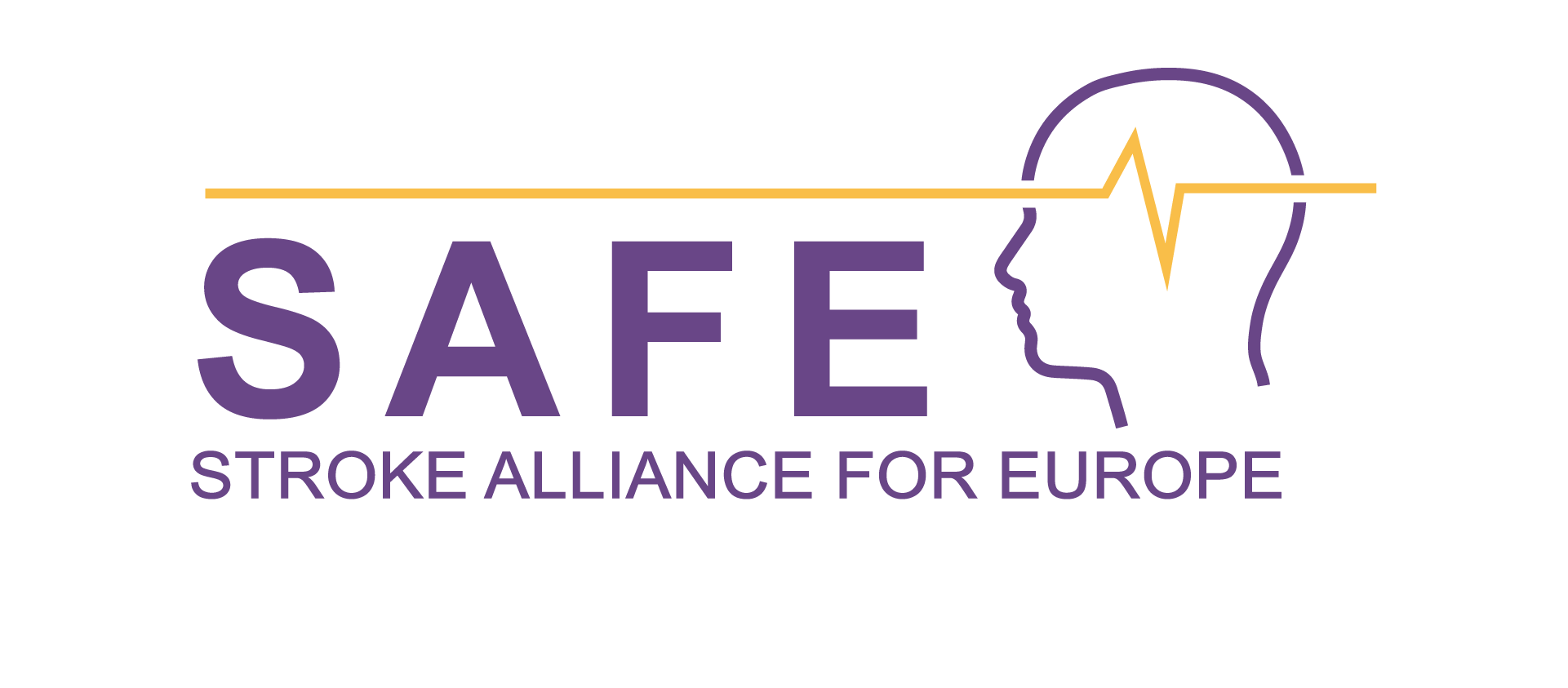


 As you go through the process of being in a severe pain through feeling just small amounts of pain, you will learn to understand and recognize your patterns. For instance, when it happens and what happens. Ask yourself whether some fears or certain emotions make things better or worse for you. If some people have an effect on your pain – be it a good one or a bad one.
As you go through the process of being in a severe pain through feeling just small amounts of pain, you will learn to understand and recognize your patterns. For instance, when it happens and what happens. Ask yourself whether some fears or certain emotions make things better or worse for you. If some people have an effect on your pain – be it a good one or a bad one.


 MBS: Every stroke is different, and so is the recovery that follows. Patients suffer not just physical problems like weakness and impaired gait, but also difficulties with language, memory, cognition and emotional problems. Patients everyday life changes and become full of obstacles and frustration.
MBS: Every stroke is different, and so is the recovery that follows. Patients suffer not just physical problems like weakness and impaired gait, but also difficulties with language, memory, cognition and emotional problems. Patients everyday life changes and become full of obstacles and frustration.
 Mark started the Stroke Stories podcast to seek out and hear from stroke survivors.
Mark started the Stroke Stories podcast to seek out and hear from stroke survivors.
 The BoE outlines clear focus areas and proposes recommendations for policy actions, which, if implemented, would significantly improve quality of life for people with neurological and chronic pain disorders, as well as their families and carers.
The BoE outlines clear focus areas and proposes recommendations for policy actions, which, if implemented, would significantly improve quality of life for people with neurological and chronic pain disorders, as well as their families and carers.

